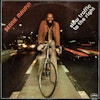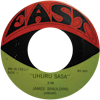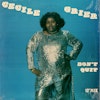Much of what I have heard about Bennie Maupin from his former Headhunters bandmates as well as journalist colleagues is that he is somewhat of an incorrigible old codger. The cover of Slow Traffic to the Right is probably one of the few times any of us have seen him smile. To hear drummer Mike Clark tell it, in the Headhunters, he and bassist Paul Jackson provided rhythmic Oakland strokes, percussionist Bill Summers added texture through his New Orleans roots and Afro-Latin studies, and Maupin and leader Herbie Hancock were egghead Midwestern musicologists who wouldn’t know funk if it was smeared all over their faces.
But by 1977, Hancock was knee-deep into the groove thing, owing a great debt to Sly Stone, and lesser ones, though no less significant, to George Duke and Bernie Worrell. He had released a slew of funk excursions starting with his genre-bending Head Hunters in 1973, turning a corner and finding success in a pop climate that drove many of the old vanguard into a wall. Miles Davis flipped jazz inside and out consistently, but would go to his grave never quite finding The One.
Maupin appeared to be heading in the same direction as Davis prior to Slow Traffic to the Right. He had proven his ability to play in a funk context with the Headhunters, but his formal background and studious nature were more suited to traditional jazz and the nascent electric stylings of his work on Davis’s Bitches Brew and Hancock’s early ’70s Mwandishi-era Warner Brothers recordings.
Clark claims that he and Jackson were the ones who taught Hancock the funk. If this is true, then all three deserve at least some of the credit for Slow Traffic to the Right. Maupin’s first date as a leader, 1974’s The Jewel in the Lotus (ECM), is full of thoughtful and well-crafted compositions of the abstract variety, but it’s hardly funky, and quite genteel compared to the Head Hunters opus he contributed to just one year earlier.
Slow Traffic to the Right is that funk, at least in parts, like the opener “It Remains to Be Seen” and the classic break in “You Know the Deal.” The album is considerably more accessible than The Jewel in the Lotus, and Maupin even cracks a smile on its cover as he rides his bike on the center median. It’s a metaphor of sorts: much like Hancock, the multi-reedist had found fertile ground between the fast-paced commercial lane to his left and the state of jazz music in the late ’70s—the proverbial “slow traffic to the right.”


